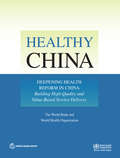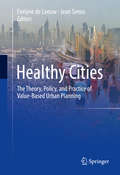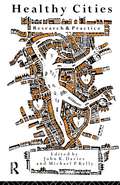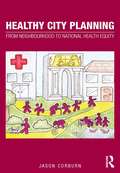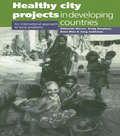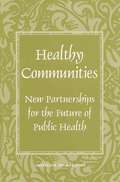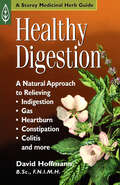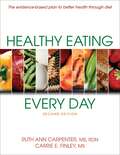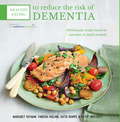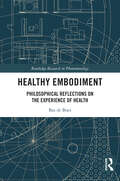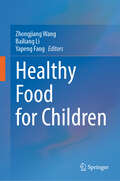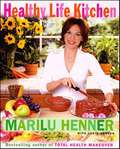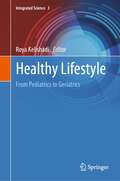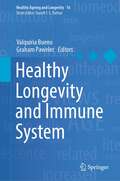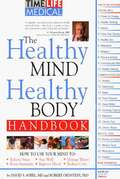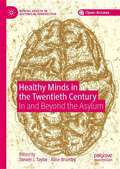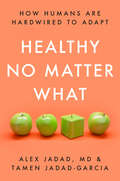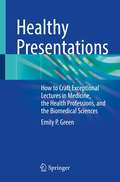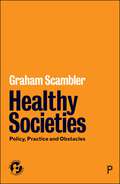- Table View
- List View
Healthy China: Building High-Quality and Value-based Service Delivery
by The World Bank;World Health OrganizationThe report recommends that China maintain the goal and direction of its healthcare reform, and continue the shift from its current hospital-centric model that rewards volume and sales, to one that is centered on primary care, focused on improving the quality of basic health services, and delivers high-quality, cost-effective health services. With 20 commissioned background studies, more than 30 case studies, visits to 21 provinces in China, the report proposes practical, concrete steps toward a value-based integrated service model of healthcare financing and delivery, including: 1) Creating a new model of people-centered quality integrated health care that strengthens primary care as the core of the health system. This new care model is organized around the health needs of individuals and families and is integrated with higher level care and social services. 2) Continuously improve health care quality, establish an effective coordination mechanism, and actively engage all stakeholders and professional bodies to oversee improvements in quality and performance. 3) Empowering patients with knowledge and understanding of health services, so that there is more trust in the system and patients are actively engaged in their healthcare decisions. 4) Reforming public hospitals, so that they focus on complicated cases and delegate routine care to primary-care providers. 5) Changing incentives for providers, so they are rewarded for good patient health outcomes instead of the number of medical procedures used or drugs sold. 6) Boosting the status of the health workforce, especially primary-care providers, so they are better paid and supported to ensure a competent health workforce aligned with the new delivery system. 7) Allowing qualified private health providers to deliver cost-effective services and compete on a level playing field with the public sector, with the right regulatory oversight, and 8) Prioritizing public investments according to the burden of disease, where people live, and the kind of care people need on a daily basis.
Healthy Cities
by Evelyne De Leeuw Jean SimosThis forward-looking resource recasts the concept of healthy cities as not only a safe, pleasant, and green built environment, but also one that creates and sustains health by addressing social, economic, and political conditions. It describes collaborations between city planning and public health creating a contemporary concept of urban governance--a democratically-informed process that embraces values like equity. Models, critiques, and global examples illustrate institutional change, community input, targeted assessment, and other means of addressing longstanding sources of urban health challenges. In these ambitious pages, healthy cities are rooted firmly in the worldwide movement toward balanced and sustainable urbanization, developed not to disguise or displace entrenched health and social problems, but to encourage and foster solutions. Included in the coverage: Towards healthy urban governance in the century of the city Healthy cities emerge: Toronto, Ottawa, Copenhagen The role of policy coalitions in understanding community participation in healthy cities projects Health impact assessment at the local level The logic of method for evaluating healthy cities Plus: extended reports on healthy cities and communities in North and Latin America, Africa, Europe, Asia, Oceania, and the Middle East Healthy Cities will interest and inspire community leaders, activists, politicians, and entrepreneurs working to improve health and well-being at the local level, as well as public health and urban development scholars and professionals.
Healthy Cities: Research and Practice
by John K. Davies Michael P. KellyThe growth of health promotion as a topic for discussion and a principle for practice is widespread, and affects all groups of health professionals. The Healthy Cities project, like Health for All, was inaugurated by the World Health Organization and has informed policy throughout the world. Healthy Cities: Research and Practice examines the application of the project in a number of countries. The contributors explore problems in the relationship between policy makers, communities, and academic researchers, and discuss how the Healthy Cities program affects housing policy, community development, scientific interchange and health education. In addition, the Editors, John Davies and Michael Kelly, provide a context by tracing the history of the WHO projects and discuss them in the broader context of scientific and philosohical debates about modernism and post-modernism. The contributors are drawn from practitioners and scientists with wide experience in the area from the United Kingdom, Canada, Australia and the United States. Healthy Cities will be invaluable to all those working at community level and in government with an interest in health, as well as students of health promotion.
Healthy City Planning: From Neighbourhood to National Health Equity (Planning, History and Environment Series)
by Jason CorburnHealthy city planning means seeking ways to eliminate the deep and persistent inequities that plague cities. Yet, as Jason Corburn argues in this book, neither city planning nor public health is currently organized to ensure that today’s cities will be equitable and healthy. Having made the case for what he calls ‘adaptive urban health justice’ in the opening chapter, Corburn briefly reviews the key events, actors, ideologies, institutions and policies that shaped and reshaped the urban public health and planning from the nineteenth century to the present day. He uses two frames to organize this historical review: the view of the city as a field site and as a laboratory. In the second part of the book Corburn uses in-depth case studies of health and planning activities in Rio de Janeiro, Nairobi, and Richmond, California to explore the institutions, policies and practices that constitute healthy city planning. These case studies personify some of the characteristics of his ideal of adaptive urban health justice. Each begins with an historical review of the place, its policies and social movements around urban development and public health, and each is an example of the urban poor participating in, shaping, and being impacted by healthy city planning.
Healthy City Projects in Developing Countries: An International Approach to Local Problems
by Edmundo WernaWith the growth of cities and towns throughout the developing world have come significant health problems. The urban poor are particularly affected, faced with the worst of both worlds: urban problems such as pollution and stress, combined with infectious diseases common in both rural and urban areas. The Healthy City Project shows how to put health high on the agenda of urban officials, integrating it into all other planning and development decisions. Healthy City Projects in Developing Countries presents a comprehensive account of this very important and increasingly influential initiative. Drawing on experience in a range of cities it shows how to design, implement and evaluate the integration of public health into urban management. The results will be very significant to all those making and implementing urban policies, as well as those working in and on public health, urban development and environmental issues.
Healthy Communities: New Partnerships for the Future of Public Health
by Institute of Medicine Staff Michael A. Stoto Cynthia Abel Anne DievlerInformation on Healthy Communities and Public Health
Healthy Digestion: A Natural Approach to Relieving Indigestion, Gas, Heartburn, Constipation, Colitis, and More
by David HoffmannLearn to use herbs to treat a variety of digestive ailments and liver diseases. Noted herbal clinician David Hoffman explains the causes and symptoms of 14 common digestive concerns — including constipation, diarrhea, gas, heartburn, peptic ulcers, and gallstones — then offers simple herbal treatments and lifestyle changes. A comprehensive A-to-Z directory of the 37 herbs that most effective promote a healthy digestive system includes thorough preparation instructions and dosage information for gastrointestinal wellness.
Healthy Eating Every Day
by Ruth Ann Carpenter Carrie E. FinleyImprove your health and quality of life through balanced eating! Healthy Eating Every Day is a practical, evidence-based program that teaches you how to improve your eating habits in ways that fit your lifestyle.
Healthy Eating to Reduce The Risk of Dementia
by Katie Sharpe Professor Margaret RaymanDementia affects nearly 36 million people worldwide, with 7.7 million new cases every year, and has a dramatic impact on sufferers and their families. There is evidence, however, that a healthy lifestyle and diet, especially in mid-life, can help to reduce the risk of developing dementia. In this much-needed book, Margaret Rayman and her team of nutritional experts give clear and effective guidelines on how to adapt your diet and lifestyle to help protect you against this condition. In addition to general dietary advice, it includes 100 delicious and easy-to-follow recipes, all of which are based on two years of careful research. The detailed introduction summarises the team's findings and explains, in a clear and concise manner, what foods, food components and nutrients can help to protect the brain and keep it functioning to its best capacity. The introduction is followed by a tempting collection of recipes, such as Blueberry and Wheatgerm Pancakes for breakfast, Warm Chicken and Grapefruit Salad for lunch, and Baked Trout with White Wine and Fennel for dinner, with a tempting Chocolate Orange Mousse or a bright and zingy Cranberry Sorbet for dessert. The fantastic health benefits of these dishes are sure to make them a welcome addition at any stage of life.
Healthy Eating to Reduce The Risk of Dementia
by Margaret Rayman Katie SharpeDementia affects nearly 36 million people worldwide, with 7.7 million new cases every year, and has a dramatic impact on sufferers and their families. There is evidence, however, that a healthy lifestyle and diet, especially in mid-life, can help to reduce the risk of developing dementia. In this much-needed book, Margaret Rayman and her team of nutritional experts give clear and effective guidelines on how to adapt your diet and lifestyle to help protect you against this condition. In addition to general dietary advice, it includes 100 delicious and easy-to-follow recipes, all of which are based on two years of careful research. The detailed introduction summarises the team's findings and explains, in a clear and concise manner, what foods, food components and nutrients can help to protect the brain and keep it functioning to its best capacity. The introduction is followed by a tempting collection of recipes, such as Blueberry and Wheatgerm Pancakes for breakfast, Warm Chicken and Grapefruit Salad for lunch, and Baked Trout with White Wine and Fennel for dinner, with a tempting Chocolate Orange Mousse or a bright and zingy Cranberry Sorbet for dessert. The fantastic health benefits of these dishes are sure to make them a welcome addition at any stage of life.
Healthy Embodiment: Philosophical Reflections on the Experience of Health (Routledge Research in Phenomenology)
by Bas de BoerThis book provides a philosophical analysis of the experience of health and investigates how this experience is shaped by recent developments in medicine and public health. It shows how phenomenological and Foucauldian approaches to health can be systematically integrated into a general account of healthy embodiment.Many medical practitioners argue for a shift from curative to preventative medicine. Technoscientific developments now enable us to track our health and provide more effective ways to live healthily. This book argues that these developments shape how we experience our health of and others, as well as the way in which we distinguish between health and illness. Its starting point is that health is not so much an object with well-defined boundaries that can be scrutinized scientifically but is better understood as an embodied experience. The author uses phenomenology and the work of Foucault to develop a theory of healthy embodiment. He argues that experiencing oneself as a healthy subject requires being made present as a healthy object by someone or something else. He explores how the experience of health results from the interaction between being a subject and being an object and potentially involves challenging medical norms.Healthy Embodiment will be of interest to researchers and graduate students working in phenomenology, science and technology studies, medical humanities, bioethics and sociology of medicine.
Healthy Food for Children
by Zhongjiang Wang Yapeng Fang Bailiang LiThe theme of the book is to provide children with comprehensive nutrition guidance to help them maintain health as they grow. The book has outstanding features, including healthy dietary patterns for children&’s nutritional needs, nutritional functional factors for improving development, low-energy foods suitable for obese children, and foods that promote intestinal health. Readers will get scientific dietary advice from the book to help children develop good eating habits and prevent malnutrition and overweight problems. This book also provides nutritional package products that meet the needs of children in underdeveloped areas, creating a comprehensive solution for children&’s nutrition and health.
Healthy Hands: Strategies for strong, pain-free hands
by WendinIs hand pain interfering with your ability to do all you want and need to do? Find out how you can ease the pain and limitations of arthritis, carpal tunnel syndrome, and other hand ailments. Hands are unavoidably vulnerable to ailments and injuries. When they happen, your daily routine can become an ordeal, ordinary tasks can become a struggle, and simple pleasures are put aside. Fortunately, almost every hand problem can be successfully treated. Pain can be significantly reduced. Mobility and dexterity can be regained. This Special Health Report will give you an empowering understanding of your hands mechanics, the diseases that compromise their function, and most important, what you can do to treat, lessen, and prevent the major threats to your hands health and strength. Do you suffer with arthritis? The report will brief you on advances in quelling the symptoms. Youll find out about the growing choices in medications as well as promising complementary therapies and alternative remedies. The report will tell you about treatments that offer relief from carpal tunnel and other pinched nerve syndromes. Youll learn what causes trigger finger and how writers cramp is cured. The report will give you the key questions to ask yourself and your doctor before considering joint replacement surgery, and much more. So, enjoy life hands on. Order your copy of this Special Health Report now. Inside Healthy Hands, you'll discover: How the most popular oral and topical arthritis meds compare Practical tips for avoiding repetitive-stress injuries What to ask when selecting a hand therapist or surgeon The new injection thats freeing immovably curled fingers 12 exercises for stronger, more flexible hands A third surgical option for carpal tunnel syndrome The hand ailment that affects women 10 times more often than men
Healthy Kids, Happy Kids: An Integrative Pediatrician's Guide to Whole Child Resilience
by Elisa Song M.D.Do you want to know the key to raising resilient kids, from the inside out? In this groundbreaking, evidence-based guide to raising healthy kids in our modern world, Dr. Elisa Song bridges the gap between conventional and holistic pediatrics and delivers a clear roadmap to help kids thrive.Raising healthy, happy kids shouldn’t be so hard. Yet, despite living in what should be a golden age of medicine, our children are sicker than ever. At least 1 in 5 kids has eczema, and 1 in 10 has asthma, ADHD, or anxiety—and sometimes they have all of the above. Many parents are at a loss for who to turn to for trusted advice—advice that takes a root-cause, holistic approach to whole child resilience, but doesn’t dismiss the value of conventional pediatrics.Enter Elisa Song, MD, a Stanford-, NYU-, UCSF-trained pediatrician, one of the foremost pioneers and trusted experts in pediatric integrative and functional medicine. Drawing on extensive research and over 25 years of clinical experience, Dr. Song explains why your child’s gut microbiome holds the key to lifelong wellness. She shares her proven and practical plan for building physical and emotional resilience from the inside out. You will discover how to:Optimize your child’s microbiome with 5 simple steps.Empower your kids so they want to make healthy choices (and you don’t have to nag).Heal your child’s gut to get to the root cause of their chronic health concerns.Feel calm and confident using safe and effective natural therapies when your kids are sick, with an A-to-Z guide to the top 25 acute childhood ailments.Complete with helpful quizzes, exercises, protocols, and dozens of delicious, gut-friendly recipes, Healthy Kids, Happy Kids is a comprehensive, yet simple roadmap to raising resilient kids in our not-so-simple world. Thanks to Dr. Song, parents (and practitioners) finally have the power to revolutionize the future of children’s health so that their kids can thrive—no matter what life throws their way.
Healthy Landscapes: Theory and Design Approaches to Promote Health in Urban Communities
by Bin Jiang Lan Luo Xueming LiuThis book responds to the need for a comprehensive and detailed theoretical framework and systemic design approaches to improve mental, physical, social, behavioral, and ecological health in urban environments.Although rapid urban development has created enormous economic and social value, it has also brought problems that have posed serious threats to the health of urban residents. Healthy Landscapes begins by reviewing practical experience, as well as theoretical and scientific evidence, from several related disciplines around the world. This is used to construct a provisional framework consisting of ten theoretical pathways for the environment to promote mental, physical,social, behavioral, and ecological health: Relieving mental stress; restoring direct attention; promoting environmental preference; promoting sublime and transcendent perceptions; promoting active lifestyles; preventing the spread of infectious diseases; promoting ecological services; enhancing social support; promoting the sense of belonging; and improving the sense of security. From these 24 theoretical pathways, the authors go on to identify 67 critical environmental characteristics for creating healthy communities, which are used to inform the design guidelines they go on to apply to community environment scenarios.This book will be an invaluable resource for students of landscape architectural design, architecture, and urban design. It will also be an essential tool for design professionals and urban administrators who want a comprehensive understanding of the fundamental theories of healthy communities with design guidelines supported by scientific evidence.
Healthy Life Kitchen
by Marilu Henner Lorin HennerIf you're like most people, 70 percent of what's in your kitchen right now is unhealthy and has to go. Now the good news ...This book will show you that there are healthy and tasty alternatives to everything in your refrigerator and pantry, and the transition is easier than you think.When it comes to food, most of us go through a constant tug-of-war between the foods we love and the foods we feel we should be eating. But what if we didn't have to give up our favourite foods? What if we could take recipes from our childhood or our favourite cookbooks and find healthier ways to enjoy them?Marilu Henner's Healthy Life Kitchen shows you a new way, a better way, to create a "health factory" in your home. Out go the red meat, dairy, and refined sugar products, and in come the freshest fruits, vegetables, grains, soy, seafood, poultry, and seasonings imaginable-and, in a few easy steps, you've created a Healthy Life you!After inspiring legions of readers with Marilu Henner's Total Health Makeover and The 30-Day Total Health Makeover, Marilu presents the first cookbook in her bestselling series.
Healthy Lifestyle: From Pediatrics to Geriatrics (Integrated Science #3)
by Roya KelishadiThis book offers a comprehensive overview on lifestyle habits related to development of risk factors of chronic diseases. It provides a summary of the impacts of various modifiable factors that influence long-term health status. The accumulation of unhealthy lifestyle habits shows that over the life course, increasing the number, duration, and severity of unhealthy behaviors would increase the risk of disease development. This contributed volume highlights the fact that establishing a healthy lifestyle is easier and more effective than focusing on lifestyle change
Healthy Longevity and Immune System (Healthy Ageing and Longevity #16)
by Valquiria Bueno Graham PawelecThis book presents studies of the main conditions that affect health and well-being of old people. Considering the present scenario of COVID-19, the effects of this viral infection on individuals older than 65 years are also discussed. The content enables professionals of health and government for the present and future actions in this important area. Readers go through the changes occurring in organs and tissues that can interfere with susceptibility to infections, low response to vaccines, cancer, and loss of cognition during the aging process. A discussion of the central role played by the immune system in the age-related diseases and how the immunity can be impaired during the ageing process is presented. Possibilities to circumvent these conditions via healthy habits in diet, physical exercise, and new pharmacological interventions are part of the content. This book discusses how human healthy longevity is dependent, at least in part, of a functional immune system. Chapters were written for researchers in the field of aging and is especially suited for those interested in the study of immunosenescence and inflammaging affecting the health of old individuals.
Healthy Markets?: The New Competition in Medical Care
by Mark A. PetersonWhen federal and state policy makers' efforts to enact sweeping health care reform in the mid-1990s ended in stalemate, the private sector unleashed initiatives that have affected virtually every aspect of health care. With updated essays first published in issues of the Journal of Health Politics, Policy and Law, Healthy Markets? offers the most comprehensive and critical examination yet found in a single volume of the economic, political, and social implications of this recent market transformation of health care in the United States. With original contributions from leading social science health policy analysts, this volume addresses the full context of health system change. Believing that the analysis of health care change is too important to be left to economists alone, Mark A. Peterson has collected a mulitdisciplinary group of experts who revisit the contentious debate over the market approaches to health care and consider the disparate effects of these approaches on cost, quality, and coverage of both managed care and Medicaid and Medicare. While market enthusiasts applaud the enhanced efficiency, reduced excess capacity, and abatement of the decades-long health care cost explosion, a backlash has emerged among many providers and the public against the perceived excesses of the market: diminished access to care, commercialization of the physician-patient relationship, and exacerbated inequality. Contributors assess these varied responses while examining the impact that market-based applications are likely to have for future health policy making, the significance of the U.S. experience for policy makers abroad, and the lessons that these changes might provide for thinking sensibly about the future of our health care system. This volume will be useful for public policy analysts, economists, social scientists, health care providers and administrators, and others interested in the future--and in understanding the past--of American health care.Contributors. Gary S. Belkin, Lawrence D. Brown, Robert G. Evans, Martin Gaynor, Paul B. Ginsburg, Marsha Gold, Theodore R. Marmor, Cathie Jo Martin, Jonathan B. Oberlander, Mark V. Pauly, Mark A. Peterson, Thomas Rice, Deborah A. Stone, William B. Vogt, Kenneth E. Thorpe
Healthy Menopause: How to best manage your symptoms and feel better than ever (Wellbeing Quick Guides)
by Liz EarleLiz Earle provides a complete guide to the changes that occur during menopause and explains how problems can be managed using supplements, HRT and alternative therapies.Bestselling beauty and wellbeing writer Liz Earle's fully revised and updated quick guide to a healthy menopause, including: - A guide to physical changes- Common problems and how to avoid them- The pros and cons of HRT- Conventional and natural therapies - Latest research into supplements - Essential addresses
Healthy Mind Healthy Body Handbook
by David S. Sobel Robert OrnsteinA valuable new kind of prescription for health and well-being. It offers easy-to-understand practical advice on improving physical health and leading a happier, more productive life. This book not only explains the important benefits of a healthy mind and body in simple, understandable language, but gives you practical ways to improve how you feel today. From how to manage stress, moods, and illness to communicating effectively, this book offers guidance that can make a positive impact on your life now and in the future.
Healthy Minds in the Twentieth Century: In and Beyond the Asylum (Mental Health in Historical Perspective)
by Steven J. Taylor Alice BrumbyThis open access edited collection contributes a new dimension to the study of mental health and psychiatry in the twentieth century. It takes the present literature beyond the ‘asylum and after’ paradigm to explore the multitude of spaces that have been permeated by concerns about mental well-being and illness. The chapters in this volume consciously attempt to break down institutional walls and consider mental health through the lenses of institutions, policy, nomenclature, art, lived experience, and popular culture. The book adopts an international scope covering the historical experiences of Britain, Ireland, and North America. In accordance with this broad approach, contributions to the volume span academic fields such as history, arts, literary studies, sociology, and psychology, mirroring the diversity of the subject matter. This book is available open access under a CC BY 4.0 license at link.springer.com
Healthy No Matter What: How Humans Are Hardwired to Adapt
by Alex Jadad Tamen Jadad-GarciaA provocative manifesto that teaches you how to take control of your own health, no matter your age or circumstances—from an innovative doctor and his philosopher daughter&“If you care about your health or the well-being of others, read this book.&”—Ethan Kross, author of ChatterDr. Alex Jadad is the creator of the Jadad scale, which has become the world&’s most widely used methodology to assess the quality of clinical trials, and his daughter Tamen Jadad-Garcia is a health entrepreneur and philosopher. Here they combine their expertise to uncover the medical system&’s unstable foundations, which condemn you to be ill. The Jadads begin this exploration with a simple question: &“What is health?&”Through engaging stories and case studies, the Jadads expand the understanding of health beyond the medical industrial complex. They show how distant connections in your personal networks can influence key aspects of yourself, like your weight, anxiety, and addictions; how reliance on medications can be reduced by intentionally designing the places where you live, work, and play; and how comparisons with peers can shorten your life.In this practical guide, the meaning of health is redefined, putting you in the driver&’s seat and recognizing you as the most effective evaluator. Building on data and experiences from millions of people around the world, the book reveals that a healthy life is possible even with complex chronic conditions or terminal illnesses. The Jadads explain why perceiving yourself as unhealthy might actually be fatal, and how you can monitor your true health and boost it in practically any context, no matter your cultural background or socioeconomic circumstances.With wisdom and empathy, Healthy No Matter What teaches you how your natural gift of adaptability equips you to overcome any obstacle, provides actionable pointers, and shows how and when to use the medical system, so that you can thrive, regardless of the twists and turns life may take.
Healthy Presentations: How to Craft Exceptional Lectures in Medicine, the Health Professions, and the Biomedical Sciences
by Emily P. GreenThis book is a practical guide for busy clinicians and educators within the biomedical sciences on how to improve their presentations. It includes specific, practical guidance on crafting a talk, tips on incorporating interactive elements to facilitate active learning, and before-and-after examples of improved slide design. Chapters discuss all aspects of exceptional presentations such as the identification of main concepts, organization of content, and best practices for creating lectures that are focused on the facilitation of learning rather than on passive information transfer. The examples provided are grounded in the biomedical sciences where presentations are necessarily dense and rich with critical content, making this book an essential read for anyone who lectures within a biomedical curriculum or presents at professional conferences. This book also addresses hot topics in medical education such as presenting on virtual platforms, and reviewing teaching materials for diversity, inclusion, and bias. These topics are not addressed in any other books on the market, and they address real gaps in medical and health professions training. Written from the perspective of an educator with over 20 years of experience in medical education, Healthy Presentations: How to Craft Exceptional Lectures in Medicine, the Health Professions, and the Biomedical Sciences recognizes the importance of high-quality, inclusive, and learner-centered presentations, and it provides essential guidance and support to the faculty who create them.
Healthy Societies: Policy, Practice and Obstacles (21st Century Standpoints)
by Graham ScamblerCan society be healthy, and how? Is Britain a ‘healthy society’ in the 21st century? When people ponder health, they usually consider the health of the individual, but individuals co-exist in a social environment so attention should be placed on the health of communities and populations. Re-examining health, healthcare and societal health using the latest data and research, this book provides a clear, accessible account of the current state of play. Addressing definitions of health in individuals, communities and populations, definitions of society itself, changes in health over time and the contribution of healthcare to health and longevity, it also suggests ways of effectively tackling obstacles to improving health and healthcare in 21st century Britain.
